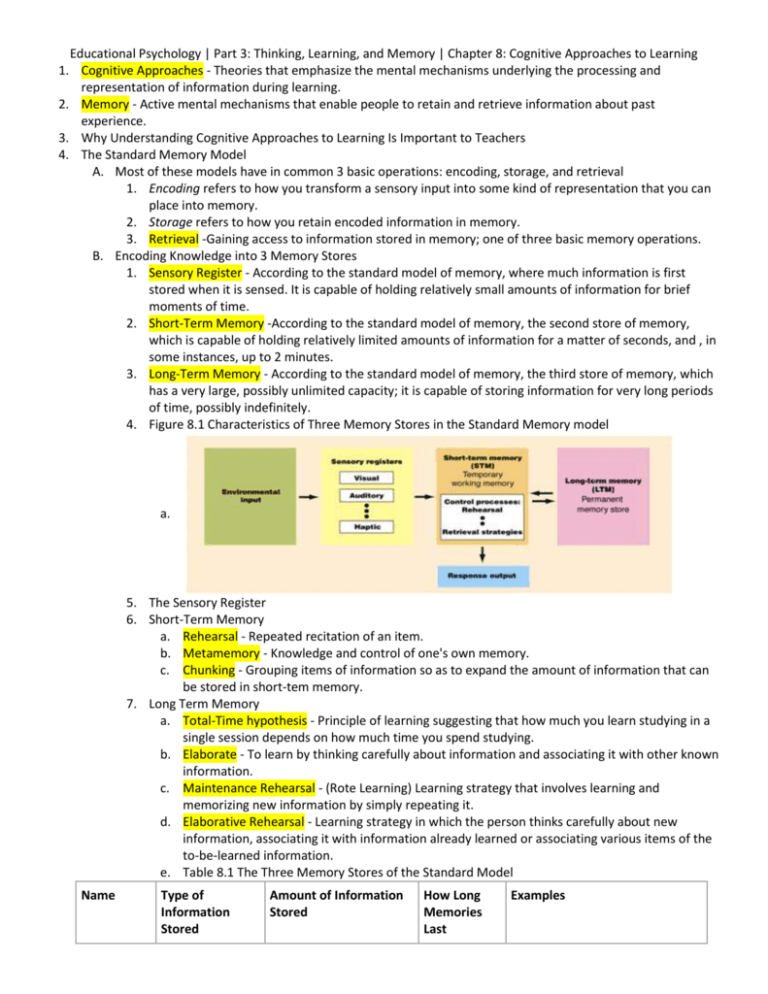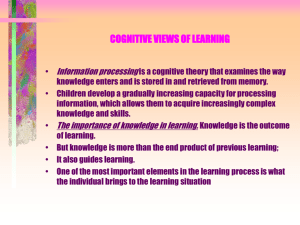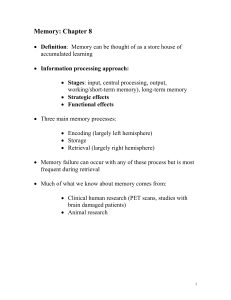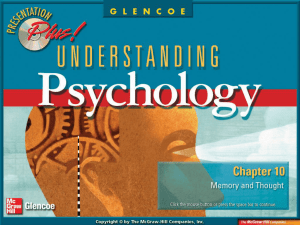Ch 8 Cognitive Approaches To Learning
advertisement

Educational Psychology | Part 3: Thinking, Learning, and Memory | Chapter 8: Cognitive Approaches to Learning 1. Cognitive Approaches - Theories that emphasize the mental mechanisms underlying the processing and representation of information during learning. 2. Memory - Active mental mechanisms that enable people to retain and retrieve information about past experience. 3. Why Understanding Cognitive Approaches to Learning Is Important to Teachers 4. The Standard Memory Model A. Most of these models have in common 3 basic operations: encoding, storage, and retrieval 1. Encoding refers to how you transform a sensory input into some kind of representation that you can place into memory. 2. Storage refers to how you retain encoded information in memory. 3. Retrieval -Gaining access to information stored in memory; one of three basic memory operations. B. Encoding Knowledge into 3 Memory Stores 1. Sensory Register - According to the standard model of memory, where much information is first stored when it is sensed. It is capable of holding relatively small amounts of information for brief moments of time. 2. Short-Term Memory -According to the standard model of memory, the second store of memory, which is capable of holding relatively limited amounts of information for a matter of seconds, and , in some instances, up to 2 minutes. 3. Long-Term Memory - According to the standard model of memory, the third store of memory, which has a very large, possibly unlimited capacity; it is capable of storing information for very long periods of time, possibly indefinitely. 4. Figure 8.1 Characteristics of Three Memory Stores in the Standard Memory model a. 5. The Sensory Register 6. Short-Term Memory a. Rehearsal - Repeated recitation of an item. b. Metamemory - Knowledge and control of one's own memory. c. Chunking - Grouping items of information so as to expand the amount of information that can be stored in short-tem memory. 7. Long Term Memory a. Total-Time hypothesis - Principle of learning suggesting that how much you learn studying in a single session depends on how much time you spend studying. b. Elaborate - To learn by thinking carefully about information and associating it with other known information. c. Maintenance Rehearsal - (Rote Learning) Learning strategy that involves learning and memorizing new information by simply repeating it. d. Elaborative Rehearsal - Learning strategy in which the person thinks carefully about new information, associating it with information already learned or associating various items of the to-be-learned information. e. Table 8.1 The Three Memory Stores of the Standard Model Name Type of Information Stored Amount of Information Stored How Long Memories Last Examples Educational Psychology | Part 3: Thinking, Learning, and Memory | Chapter 8: Cognitive Approaches to Learning Sensory Register Visual (and possibly auditory) About 9 items Up to 1 second Short-Term memory Information that 5 to 9 items; storage can Up to 1 is being currently be increased by chunking minute used information into groups without rehearsal A telephone number; a list of vocabulary words Long-Term Memory Information that Possibly unlimited has been learned or encoded for long-term storage The square root of 144 is 12; the name of your favorite candy bar; how to open you bicycle lock Possibly for life The image left after "writing" name with a sparkler, or after a teacher turns off an overhead projector A. Rote Learning - Learning by repetition with little or no attempt to add to or find meaning in the information. B. Distributed Learning - Learning done over several sessions spaced out over time. C. Massed Learning - Learning that is crammed, occurring all at one time. A. Types of Storage in Long-Term Memory 1. Table 8.2 Types of Knowledge Stored in Long-Term Memory Declarative ("Knowing That") Procedural ("Knowing How" Conditional ("Knowing Why" or "Knowing When") Type of memory used for storing it Semantic memory: widely known facts; Episodic memory: personal experiences Procedural memory: ways to do things Conditional memory: involves knowing when and how to apply to declarative and procedural knowledge you have Form in which it is stored Hierarchies or other organized networks of representations, either: Analogical (images) or Symbolic (propositions) Ordered sequences of productions (condition-action sequences) Cognitive strategies: information about the conditions under which certain declarative or procedural knowledge is useful Examples Knowing what you did with your best friend yesterday (episodic), or planning for your best friend's birthday (semantic); can be stored as a mental picture of you and your friend at the movies (analogical representation), or as a set of propositions to indicate the birthday (propositional representation) Knowing how to ride a bicycle or write a research paper Knowing when to stop doing research for a research paper A. Mental Representations - Ways in which knowledge is stored in memory. B. Declarative Knowledge 1. Declarative Knowledge - Knowledge of facts stored in semantic or episodic memory. It is sometimes described as "knowing that" 2. Semantic Memory - Long-term memory store holding general knowledge of the world. 3. Episodic Memory - Long-term memories holding personally experienced events or episodes. Educational Psychology | Part 3: Thinking, Learning, and Memory | Chapter 8: Cognitive Approaches to Learning 4. Analogical Representations - Declarative memories that preserve many aspects of the original stimulus. 5. Symbolic Representations - Declarative memories that rely on arbitrary symbols that may bear no obvious relation to whatever it is being represented. 6. Propositional Networks - Schematic integration of interrelated propositions. 7. Figure 8.2 A Propositional Network a. 8. Figure 8.3 Feature Model of Semantic Memory C. Procedural Knowledge 1. Procedural Knowledge - Knowledge of how to do certain things; "knowing how" 2. Productions (Condition-Action Sequences) - Way of storing procedural knowledge in memory as condition-action sequences that tell us, "if this, then do that" D. Conditional Knowledge 1. Conditional Knowledge - Knowledge of when and how to apply the declarative and procedural knowledge you have. Implications for Teaching The Three Memory Stores Teachers can help students move information from the sensory register through short-term memory and into long-term memory. Some of the ways in which expert teachers use the standard model of memory to help students learn more effectively include the following: A. Get students' attention. The standard memory model emphasizes getting students' attention. Attention is a prerequisite for information in the sensory register to be transferred to short-term memory, where it will be processed further. A creative way of getting your students' attention is to use large, colorful visual aids to accompany the key points of a presentation. Identify critical concepts and information, and repeat them to emphasize their importance. B. Help students develop metamemory. Teach students techniques such as chunking information (for example, French words by topic). Demonstrate the techniques in class. Model them yourself. Help students identify which memory strategies work best for them. For example, suppose the class is quizzed on key terms every week. Then for several weeks a teacher could prescribe a different memory strategy each week. After this trial period, the teacher could ask students to indicate their preferred strategies. The students also should explain why they believed these strategies worked. 3. Allow time for rehearsal Educational Psychology | Part 3: Thinking, Learning, and Memory | Chapter 8: Cognitive Approaches to Learning 4. Help students elaborate. 5. Schedule frequent practices of new information. Long-Term Memory 1. Arrange memorable learning experiences. 2. Use pictures. 3. Organize information. 4. Teach conditional knowledge. 5. Encourage "learning by doing" A. Explicit Versus Implicit Memory 1. Implicit Memory - A type of memory in which an individual recalls or recognizes information without consciously being aware of doing so. 2. In explicit memory, an individual consciously acts to recall or recognize particular information 5. Alternative Models of Memory A. Connectionist Models 1. Parallel Distributed Processing (PDP) Model - (AKA connectionist model)Model of memory that focuses on the ways declarative and procedural knowledge are combined via series of connections among elements. 2. Spreading Activation - According to the connectionist model of memory, a phenomenon whereby activation of one node may prompt activation of another, connected node. 3. Figure 8.4 A Connectionist Model of memory B. The Working-memory Model 1. Working Memory -According to the working model of memory, an active part of long-term memory that also includes temporary, or short-term memory. 2. Figure 8.5 The Working-Memory Model 3. Table 8.3 Standard Memory Model Versus Working-Memory Model Terminology Standard Memory Model Working-Memory Model Short-term memory is sometimes called working memory, but it is distinct from long-term memory Working memory includes both short-term memory and long-term memory Relationship of Short-term memory is distinct from Memory long-term memory, although Stores information may move between the 2 stores Key Emphasis of Model Short-term memory is not entirely distinct form long-term memory; rather, it is a part of working memory along with whatever information in longterm memory is currently activated On the distinctions between different On the role of activation in moving information memory stores into working memory and on the errors of working memory in memory processes A. The Levels-of-Processing Model 1. Levels-of-Processing Model - Model of memory in which storage is seen as varying along a continuous dimension in terms of depth of encoding. It suggests that the deeper the level at which an item is processed, the higher the probability that the item will be retrieved alter. 2. Figure 8.6 The Levels-of-Processing Model Educational Psychology | Part 3: Thinking, Learning, and Memory | Chapter 8: Cognitive Approaches to Learning a. 3. Self-reference Effect - Effect whereby people show very high levels of recall when asked to relate words meaningfully to themselves by determining when the words describe themselves. Implications for Teaching A. Use the ideas of priming and spreading activation to help students learn. For example, a teacher may review subtraction and multiplication as a way of priming students before teaching division. B. Help students encode information at the deepest level possible. Expert teachers know that making ideas meaningful for students is the best way to help the students learn. 6. Retrieving Information A. Tasks Used to Assess Students' Memories 1. Recall Tasks a. Recall Task - Memory task that requires a person to produce information from memory. b. Free Recall - Type of memory test in which a person must recite back a list of learned items, in any order. c. Serial Recall - Type of memory procedure in which a person must recite back a list of learned items, in the same order that the items were originally presented. d. Paired-Associates Recall - Type of memory procedure in which a person learns pairs of words. When one word in the pair is presented, the person must respond with the correct matching word. 2. Recognition Tasks a. Recognition Task - Memory test that requires a person to select or identify something he or she has learned previously. B. Facilitating Students' Retrieval 1. Retrieval Cues a. Retrieval Cues - Clues or reminders that can enhance the ability to retrieve stored information from memory. b. Advance Organizer - Way of organizing information to be learned to enhance learning. c. Encoding Specificity - Principle of memory suggesting that the context in which something is encoded substantially affects how well that something is later retrieved. 2. Mnemonists and Mnemonic Devices a. Mnemonic Devices - Specific techniques for improving learning and memory. b. Categorical Clustering c. Interactive Images d. Pegwords e. Method of Loci f. Acronyms g. Acrostics h. Keywords i. PQ4R - Mnemonic device for the steps in a study method: Preview, Question, Read, Reflect, Recite, and Review. Educational Psychology | Part 3: Thinking, Learning, and Memory | Chapter 8: Cognitive Approaches to Learning 3. Flashbulb Memories C. Retrieval Failure 1. Decay Theory - Theory of memory suggesting that information is forgotten because of the gradual disappearance over time of an unused memory trace. 2. Interference Theory - Theory suggesting that forgetting is caused by competing information that renders the sought-after information inaccessible. 3. Retroactive Interference (AKA Retroactive Inhibition) - Forgetting caused by activity that occurs after something is learned. 4. Proactive interference (AKA Proactive Inhibition) - Forgetting caused by activity that occurs before something is learned. 5. Serial-Position Curve 6. Figure 8.8 The Serial-Position curve a. D. Biology of Memory 7. Constructivist Approaches A. Constructivist Approaches - Approach to learning based on the idea that children actively build their own knowledge. It suggests that prior experience and the context of learning affect how we encode memories, how we recall, and what we recall. B. Constructivist Approaches to Memory 1. Schemas a. Schemas - Cognitive frameworks for organizing associated concepts. 2. Autobiographical Memory 3. Memory Distortions a. Transience b. Absent-Mindedness c. Blocking d. Misattribution e. Suggestibility f. Bias g. Persistence 4. Eyewitness Testimony a. Unreliable, we fill in the gaps 5. Children's Memories 6. Scripts Educational Psychology | Part 3: Thinking, Learning, and Memory | Chapter 8: Cognitive Approaches to Learning a. Scripts - Stereotypical story outline for how events typically proceed. C. Constructivist Approaches to Learning 1. Situated Learning 2. Enculturation 3. PIFS (Practical Intelligence for School) has 5 key components: a. Knowing Why b. Knowing Self c. Knowing Differences d. Knowing Process e. Reworking 4. Table 8.4 Kinds of Memory Kind of Memory Definition Episodic Encoding storage and retrieval of events or episodes that the rememberer experienced personally at a particular point in time Semantic Encoding, storage, and retrieval of facts that do not describe the unique experiences of the individual recalling the facts, and that are not characterized by any particular temporal context in which the individual acquired the facts. Declarative A recognition and understanding of factual information ("knowing that") Procedural A recognition and awareness of how to perform particular tasks, skills or procedures ("knowing how") Recall A process of memory often used in memory tasks, in which the individual is asked to produce (not just to recognize as correct) a fact, word, or another item from memory. Recognition A process of memory often used in memory tasks, in which the individual is asked just to recognize as correct (not to produce) a fact, a word, or another item from memory.





![Transformational Change [Powerpoint Presentation]](http://s2.studylib.net/store/data/005447411_1-da0a83bd34bdb90183940ab700125003-300x300.png)
